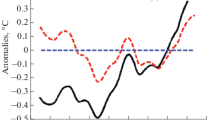Abstract
Considerable controversy has been generated by the observation that the Earth's climate has warmed over the last century. Public policy decisions hinge on the question of whether this trend is natural climate variability or the result of the increase in atmospheric concentrations of greenhouse gases. The strength of the enhanced greenhouse effect depends, in large part, on the uncertain value of climate sensitivity. In this paper climate sensitivity is estimated from the global temperature record by assuming models for greenhouse forcing, climate response to forcing, and climate variability. We find optimal estimates of climate sensitivity are remarkably insensitive to assumptions, at least for forcing excluding the effect of aerosols, and these values are considerably less than most predictions arising from General Circulation Models (GCM's). It is, however, the statistical significance of these estimates that is sensitive to assumptions about climate variability. Assuming climate variability with a time scale of a decade or less, climate sensitivity is estimated to be significantly greater than zero, but also significantly lower than that predicted by GCM's. Climate variability with a century time scale is consistent with both the recent temperature record and the pre-instrumental record for the last millenium; if this type of variability is assumed, the estimate of climate sensitivity has a confidence band wide enough to encompass both zero and typical values obtained by GCM's. With century time-scale variability it will be several decades before confident estimates can be made.
Similar content being viewed by others
References
Barnett, T. and Schlesinger, M. E.: 1987, ‘Detecting Changes in Global Climate Induced by Greenhouse Gases’,J. Geophys. Res. 92, 14,772–14,780.
Beyer, W. T.: 1966,CRC Handbook of Tables for Probability and Statistics, Chemical Rubber Co., Cleveland, Ohio, pp. 27–29.
Bradley, R. S.: 1991, ‘Pre-Instrumental Climate: How Has Climate Varied During the Past 500 Years?’, in Schlesinger, M. E. (ed.),Greenhouse-Gas-Induced Climatic Change: A Critical Appraisal of Simulations and Observations, Elsevier, Amsterdam, pp. 391–410.
Broecker, W. S., Bond, G., and Klas,M.: 1990, ‘A Salt Oscillator on the Glacial Atlantic?’,Paleoceanography 5, 469–477.
Charlson, R. J., Langner, J., Rhodhe, H., Leovy, C. B., and Warren, S. G.: 1991, ‘Perturbation of the Northern Hemisphere Radiative Balance by Backscattering of Anthropogenic Sulfate Aerosols’,Tellus 43, 152–163.
Charlson, R. J., Schwartz, S. E., Hales, J. M., Cess, R. D., Coakley, J. A. Jr., Hansen, J. E., and Hofmann, D. J.: 1992, ‘Climate Forcing by Anthropogenic Aerosols’,Science 255, 423–430.
Eddy, J. A.: 1976, ‘The Maunder Minimum’,Science 192, 1189–1202.
Friis-Christensen, E. and Lassen, K.: 1991, ‘Length of the Solar Cycle: An Indicator of Solar Activity Closely Associated with Climate’,Science 254, 698–700.
Grove, J. M.: 1988,The Little Ice Age, Methuen, London.
Hansen, J., Fung, I., Lacis, A., Rind, D., Lebedeff, S., Ruedy, R., and Russell, G.: 1988, ‘Global Climate Changes as Forecast by Goddard Institute for Space Studies Three-Dimensional Model’,J. Geophys. Res. 93, 9341–9364.
Hansen, J. E. and Lacis, A. A.: 1990, ‘Sun and Dust Versus Greenhouse Gases: An Assessment of Their Relative Roles in Global Climate Change’,Nature 346, 713–719.
Hansen, J. E. and Lebedeff, S.: 1988, ‘Global Surface Temperatures: Update Through 1987’,Geophys. Res. Lett. 16, 323–326.
Hoffert, M. I. and Flannery, B. P.: 1985, in MacCracken, M. C. and Luther, F. M. (eds.)Projecting the Climatic Effects of Increasing Carbon Dioxide, U.S. Department of Energy, Washington DC, pp. 149–190.
Houghton, J. T., Jenkins, G. J., and Ephraums, J. J.: 1990,Climate Change: The IPCC Scientific Assessment, Cambridge University Press, Cambridge, U.K.
Hughes, M. K.: 1991, ‘Tree Rings as a Source of Information on Climate Change since the Little Ice Age’,EOS 72, 68.
Jones, G. A.: 1991, ‘A Stop-Start Ocean Conveyer’,Nature 349, 364–365.
Jones, P. D.: 1988, ‘The Influence of ENSO on Global Temperature’,Clim. Monitor 17, 81–89.
Jones, P. D. and Wigley, T. M. L.: 1990, ‘Global Warming Trends’,Scient. Amer. 263, 84–91.
Lewis, T. J., Wang, K., and Jessop, A. M.: 1991, ‘Climatic Change in Eastern Canada Inferred from Borehole Temperature Data’,EOS 72, 69.
Kerr, R. A.: 1991, ‘Could the Sun Be Warming the Climate’,Science 254, 652–653.
Parker, D. E. and Folland, C. K.: 1991, ‘Worldwide Surface Temperature Trends Since the Mid-19th Century’, in Schlesinger, M. E. (ed.)Greenhouse-Gas-Induced Climatic Change: A Critical Appraisal of Simulations and Observations, Elsevier, Amsterdam, pp. 173–194.
Rasmusson, E. M., Wang, X., and Ropelewski, C. F.: 1990, ‘The Biennial Component of ENSO Variability’,J. Mar. Sys. 1, 71–84.
Reid, G. C.: 1987, ‘Influence of Solar Variability on Sea Surface Temperatures’,Nature 329, 142–143.
Schönwiese, C-D. and Runge, K.: 1991, ‘Some Updated Statistical Assessments of the Surface Temperature Response to Increased Greenhouse Gases’,Int. J. Clim. 11, 237–250.
Schönwiese, C-D. and Stähler, U.: 1991, ‘Multiforced Statistical Assessments of Greenhouse-Gas-Induced Surface Air Temperature Change 1890–1985’,Clim. Dynam. 6, 23–33.
Seitz, F., Jastrow, R., and Nierenberg, W. A.: 1990,Global Warming: What Does the Science Tell Us, Marshall Institute, Washington, D.C.
Stouffer, R. J., Manabe, S., and Bryan, K.: 1989, ‘Interhemispheric Asymmetry in Climate Response to a Gradual Increase of CO2’,Nature 342, 660–662.
Thompson, L. G., Moseley-Thompson, E., Lin, N. P., Davis, M. E., and Dai, J.: 1991, ‘Ice Core Evidence of Climatic Change Since the Little Ice Age: Evidence for Recent Warming in Central Asia’,EOS 72, 66.
Tsonis, A. A. and Elsner, J. B.: 1989, ‘Testing the Global Warming Hypothesis’,Geophys. Res. Lett. 16, 795–797.
Wang, P. K.: 1991, ‘Climatic Change in China Since the Little Ice Age as Revealed by Chinese Historical Documents’,EOS 72, 71.
Wigley, T. M. L.: 1990, Personal communication.
Wigley, T. M. L. and Kelly, P. M.: 1990, ‘Holocene Climatic Change,14C Wiggles and Variations in Solar Irradiance’,Phil. Trans. R. Soc. A330, 547–560.
Wigley, T. M. L. and Jones, P. D.: 1981, ‘Detecting CO2-Induced Climatic Change’,Nature 292, 205–208.
Wigley, T. M. L. and Raper, S. C. B.: 1990, ‘Natural Variability of the Climate System and Detection of the Greenhouse Effect’,Nature 344, 324–327.
Author information
Authors and Affiliations
Rights and permissions
About this article
Cite this article
Kheshgi, H.S., White, B.S. Does recent global warming suggest an enhanced greenhouse effect?. Climatic Change 23, 121–139 (1993). https://doi.org/10.1007/BF01097333
Received:
Revised:
Issue Date:
DOI: https://doi.org/10.1007/BF01097333




